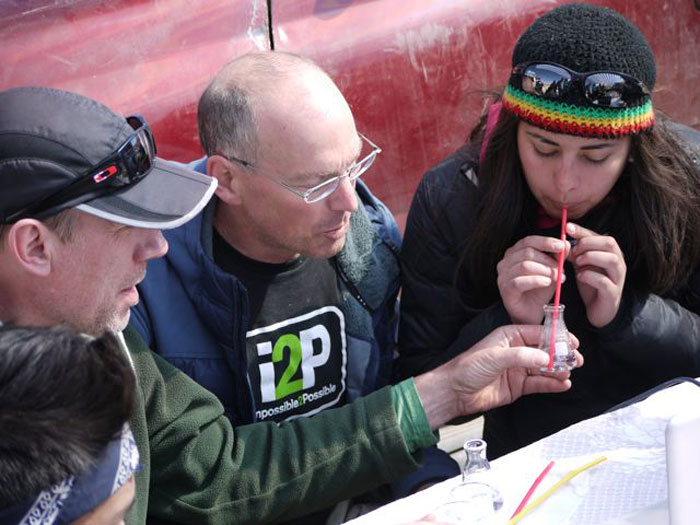
CARBONATE/BICARBONATE BUFFER
Date
May 16
Purpose
Illustrate how a set of related compounds create a chemical system, termed a buffer, which is resistant to change in pH.
Discussion
At 12,000 feet the atmospheric pressure on the Salar de Uyuni is reduced, meaning the oxygen availability is decreased. The reduced oxygen will stress the youth ambassadors, and may cause a measurable change in their blood pH. pH is the scientific term for the acidity of a solution. Lemon juice, acetic acid (vinegar), and sulfuric acid (the acid in 'acid rain') are examples of acids. Hand soap is basic, and pure water that has been recently boiled is neutral. There is a range of acidity and basicity.
Many different sets of related compounds can be used as a pH buffer. A buffer consists of an acid and a base. The acid and the base can be related, in that the acid can donate a proton to the base, itself becoming the base and vice-versa. There are buffers in our blood and in the ocean. In the ocean, carbon in the forms of bicarbonate and carbonate form a buffer, which are connected to carbon, as carbon dioxide, in the atmosphere.
Let's first introduce where these compounds come from, by way of introducing the carbonate/bicarbonate buffer that is in the oceans. Carbonate (CO3-2) comes from the dissolution and weathering of organisms such as phytoplankton, corals, and rock. Carbonic acid, is produced when carbon dioxide (CO2(g)) reacts with water (H2)) to form carbonic acid (H2CO3). Because there is a large supply of carbonate, the carbonic acid readily loses a proton by reacting with carbonate, forming two equivalents of bicarbonate (H2CO3 + CO3-2 = 2HCO3-). This chemistry establishes a large reservoir of both carbonate and bicarbonate, and the relative amount of these two compounds (and their propensity to donate or receive a proton) determines the pH of the oceans. The ph of the oceans is currently 8.14. two hundred years ago, the pH of the oceans was 8.25, and the shift toward a lower pH is attributed to increased CO2 in the atmosphere from human use of petroleum over the past few hundred years.
Method
Youth Ambassadors will exercise strenuously which will cause them to produce more CO2. The CO2 in exhaled breath will be used to illustrate the acidification of pure water. Dyes, organic compounds that change color at different pHs, will be used as pH indicators. Then a series of carbonate/bicarbonate buffers will be prepared and used to illustrate pH buffering, by adding (a) exhaled breath and (b) a strong acid.
Experiment Report & Results

This experiment was broadcast live over the internet via satellite. We introduced the experiment with a coverage of common acids and bases found in a typical home. Next we introduced how physical exertion causes the production of hydronium ion (a proton attached to a single water molecule, H3O+). The hydronium ion combines with the buffer in our blood stream, and is transported using a protein (carbonic anhydrase) as carbonic acid, H2CO3. In our lungs, this acid is exhaled as carbon dioxide (CO2) and water (H2O). Therefore, the first portion of the live experiment was in fact the reverse of what happens in our lungs; when Youth Ambassador Barbara exhaled into water, the CO2 in her breath recombined with water in the beaker, forming carbonic acid, H2CO3. In the case of the pure water containing a drop of indicator bromothymol blue, the carbonic acid loses one proton which then reacts with the indicator, causing it to be protonated and as a result, the indicator molecule changes color from blue to colorless. (Carbonic acid can then donate up to 2 protons in total, depending on the pH of the solution. The ability for an acid to donate a proton is termed acid dissociation constant, Ka. A strong acid, like hydrochloric acid has a Ka of 1, while a weak acid like carbonic acid has a Ka1 = 4.45x10-7 and Ka2 = 4.7x10-11 for the loss of the first and second proton respectively.)
We also learned in this experiment that there are systems where changes in pH are minimized by pH buffers. A buffer is able to absorb an acid or base with only a very small change in the pH of the system, whereas, an non-buffered system to which an acid or base is added will experience a, by comparison, a larger change in pH. One type of pH buffer is the bicarbonate:carbonate buffer (HCO3-:CO32-), which is present in our blood stream at pH = 7.4 and in the oceans at pH = 8.1. The strength of a buffer is measured in terms of its resistance to change in pH. Notice that carbonic acid, bicarbonate, and carbonate are related by the sequential addition or removal of a proton. We also mentioned that a human being would not function well if their blood was not buffered, because the biochemical pathways that involve proteins would not work well if the pH was not equal to 7.4. I'll close this section with a challenge: can you describe the relationship between the pH of the oceans and why an increasing concentration of carbon dioxide in the atmosphere may be harmful to marine biodiversity? Will an increasing concentration of carbon dioxide in the atmosphere be beneficial or harmful to terrestrial biodiversity?
Answer to student query during live experiment:








